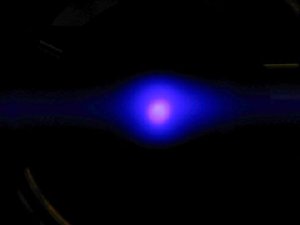An experimental atomic clock based on ytterbium atoms is about four times more accurate than it was several years ago, giving it a precision comparable to that of the NIST-F1 cesium fountain clock, the nation's civilian time standard, scientists at the National Institute of Standards and Technology (NIST) report in Physical Review Letters.*
 This photo shows about 1 million ytterbium atoms illuminated by a blue laser in an experimental atomic clock that holds the atoms in a lattice made of intersecting laser beams. The photo was taken with a digital camera through the window of a vacuum chamber. NIST is studying the possible use of ytterbium atoms in next-generation atomic clocks based on optical frequencies, which could be more stable and accurate than today's best time standards, which are based on microwave frequencies. Credit: Barber, NIST
This photo shows about 1 million ytterbium atoms illuminated by a blue laser in an experimental atomic clock that holds the atoms in a lattice made of intersecting laser beams. The photo was taken with a digital camera through the window of a vacuum chamber. NIST is studying the possible use of ytterbium atoms in next-generation atomic clocks based on optical frequencies, which could be more stable and accurate than today's best time standards, which are based on microwave frequencies. Credit: Barber, NIST
NIST scientists evaluated the clock by measuring the natural frequency of ytterbium, carefully accounting for all possible deviations such as those caused by collisions between the atoms, and by using NIST-F1 as a "ruler" for comparison. The results were good enough to indicate that the ytterbium clock is competitive in some respects with NIST-F1, which has been improving steadily and now keeps time to within 1 second in about 100 million years. (Because the international definition of the second is based on the cesium atom, technically no clock can be more accurate than cesium standards such as NIST-F1.) More importantly, the improved ytterbium clock gives the time standards community more options in the ongoing development and comparisons of next-generation clocks, says NIST physicist Chris Oates, an author of the new paper.
The NIST ytterbium clock is based on about 30,000 heavy metal atoms that are cooled to 15 microkelvins (close to absolute zero) and trapped in a column of several hundred pancake-shaped wells-an "optical lattice"-made of laser light. A laser that "ticks" 518 trillion times per second induces a transition between two energy levels in the atoms. The clock's enhanced performance was made possible by improvements in the apparatus and a switch to a different form of ytterbium whose nucleus is slightly magnetic due its "spin-one half" angular momentum. This atom is less susceptible to key errors than the "spin-zero" form of ytterbium used previously.
NIST scientists are developing five versions of next-generation atomic clocks, each using a different atom and offering different advantages. The experimental clocks all operate at optical (visible light) frequencies, which are higher than the microwave frequencies used in NIST-F1, and thus can divide time into smaller units, thereby yielding more stable clocks. Additionally, optical clocks could one day lead to time standards up to 100 times more accurate than today's microwave clocks.
The best optical clocks are currently based on single ions (electrically charged atoms), such as the NIST "logic clock" using an aluminum ion (see "NIST 'Quantum Logic Clock' Rivals Mercury Ion as World's Most Accurate Clock".) But lattice clocks have the potential for higher stability because they simultaneously average signals from tens of thousands of atoms. Ongoing comparisons of the ytterbium clock to that of the strontium lattice clock located nearby at JILA, a joint institute of NIST and the University of Colorado at Boulder, (see "Collaboration Helps Make JILA Strontium Atomic Clock 'Best in Class'") should help enable worldwide tests of optical clock performance with extremely high precision. JILA is At this point it is far from clear which atom and clock design will be selected by research groups around the world as a future time and frequency standard.
Advances in atomic clock performance support development of technologies such as high data rate telecommunications and the Global Positioning System (GPS). Optical clocks are already providing record measurements of possible changes in the fundamental "constants" of nature, a line of inquiry that has huge implications for cosmology and tests of the laws of physics, such as Einstein's theories of special and general relativity. Next-generation clocks might lead to new types of gravity sensors for exploring underground natural resources and fundamental studies of the Earth. Other possible applications may include ultra-precise autonomous navigation, such as landing planes by GPS.
* N. D. Lemke, A. D. Ludlow, Z.W. Barber, T. M. Fortier, S.A. Diddams, Y. Jiang, S. R. Jefferts, T. P. Heavner, T. E. Parker and C.W. Oates. Spin-1/2 optical lattice clock. Physical Review Letters. Published online Aug. 3, 2009.